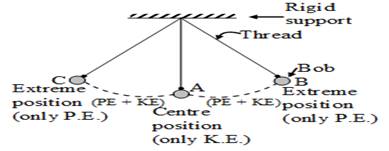Explain how, the total energy a swinging pendulum at any instant of time remains conserved. Illustrate your answer with the help of a labeled diagram.
A swinging pendulum is a perfect example to show the conservation of energy. It shows the transformation of potential energy into kinetic energy and kinetic energy back into potential energy without any energy loss. In a pendulum, the law establishes that, when the ball is at its highest point, all the energy is potential energy and there is zero kinetic energy. At the ball's lowest point, all the energy in the ball is kinetic and there is zero potential energy. The total energy of the ball is the sum of the potential energy and kinetic energy.
Initially, the bob of the pendulum is at the mean position (B). When we draw the pendulum bob to one side (Extreme position A), we raise the bob to a little height end give it potential energy. This is the energy transferred by work done by hand. As at the extreme position, the bob has only PE, it tends to move down. The P.E decreases and K.E increases. At the lowest (mean) position, the bob has got K.E. Due to this it moves to the other side. Now, its K.E decreases and P.E increases. At the extreme positions A and C, all energy is in the form of potential energy and therefore it tends to move down. Thus the bob oscillates. At all other intermediate positions, energy of the pendulum is partly potential and partly kinetic. But, the total energy of the pendulum remains conserved.
